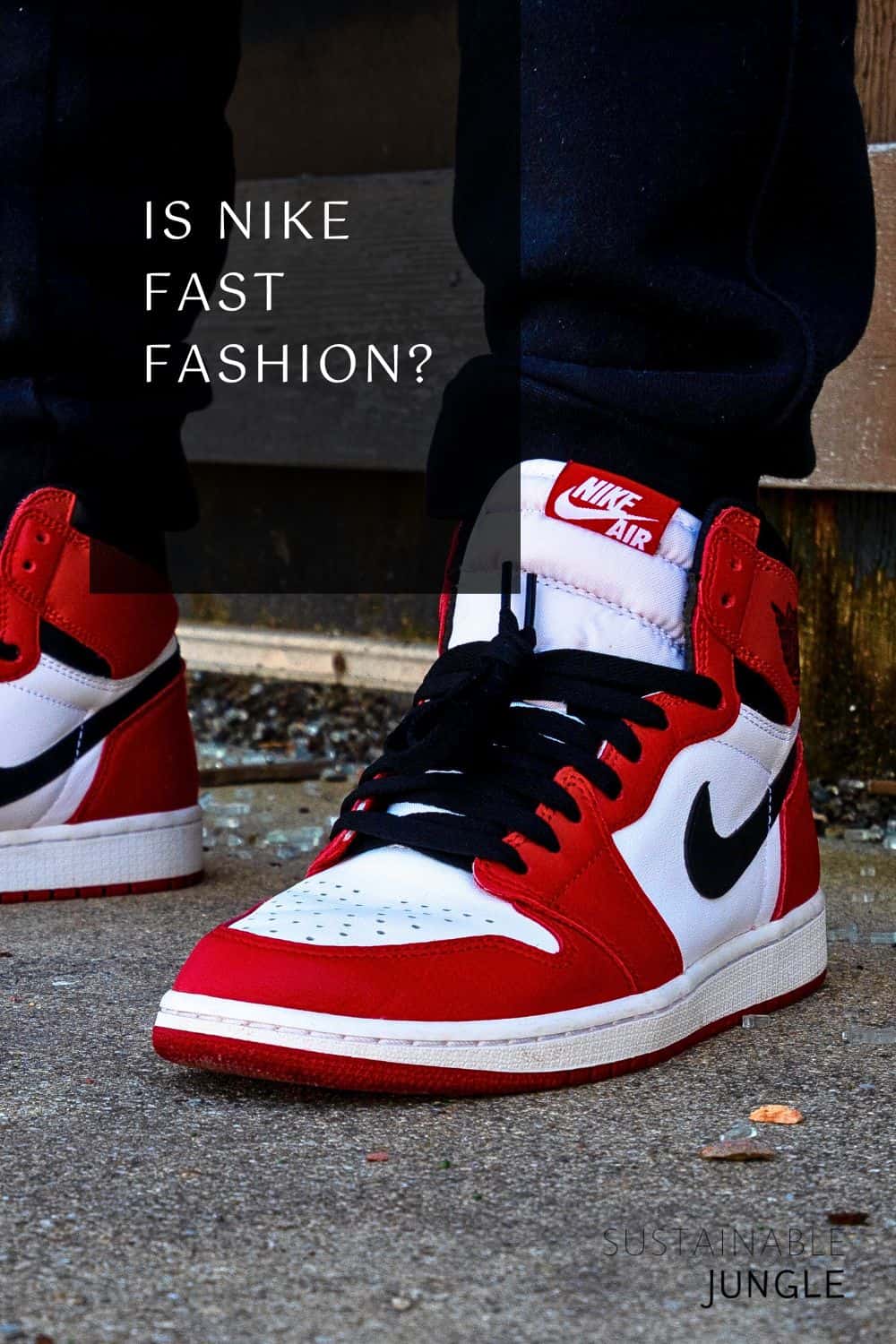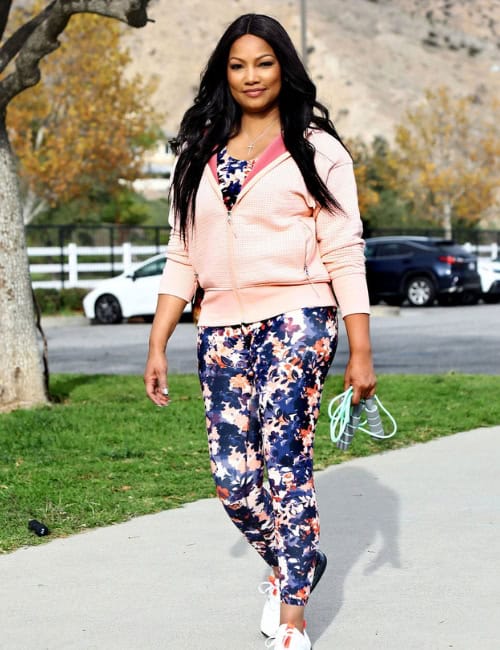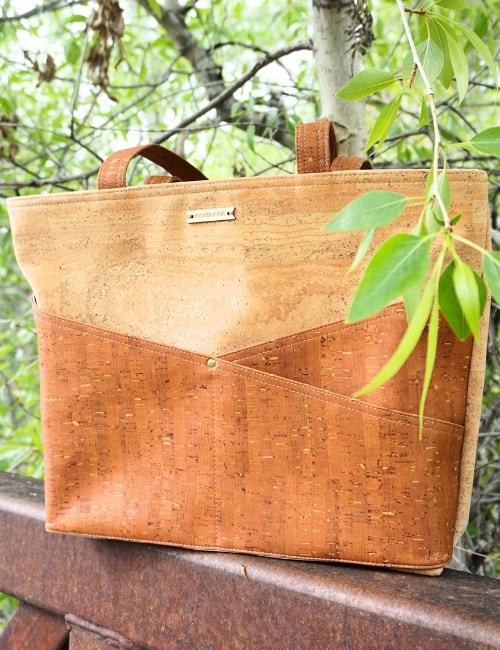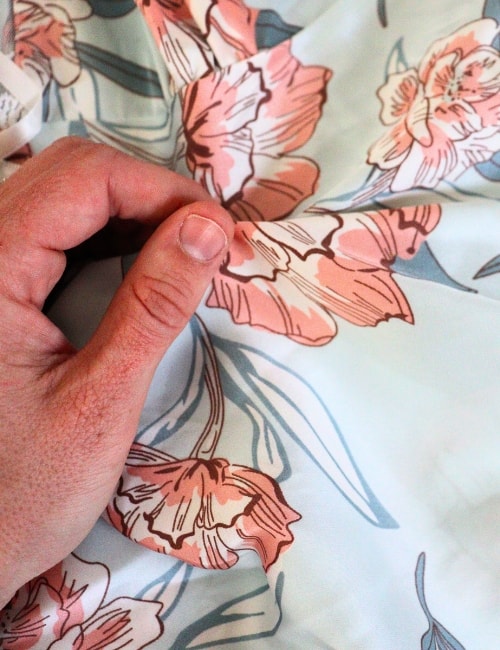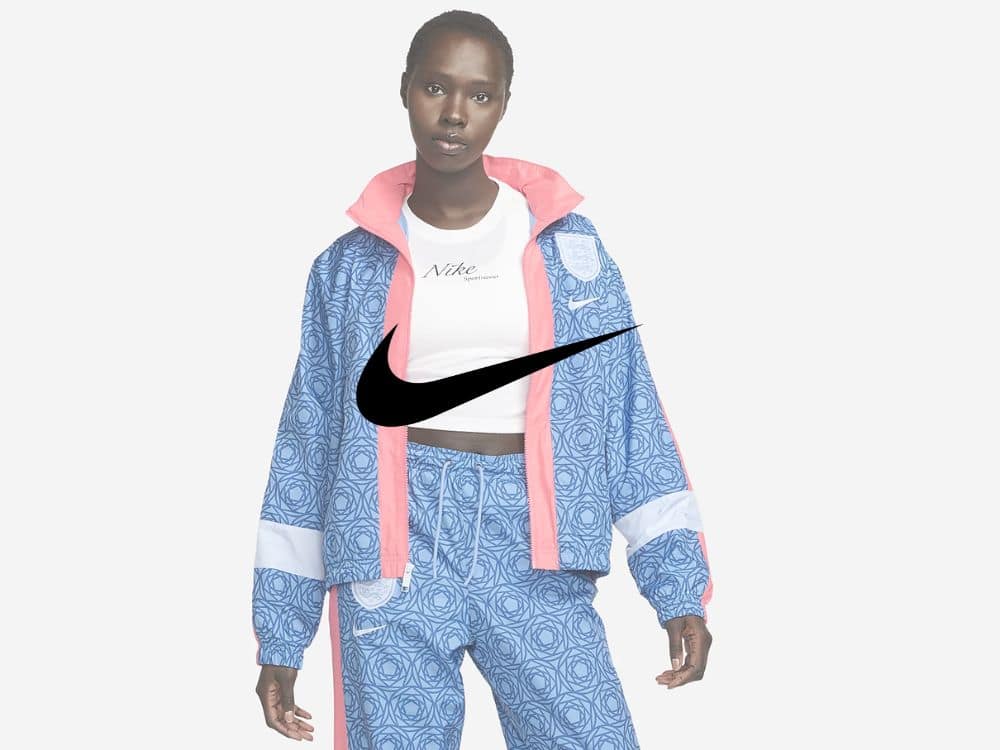
Is Nike Fast Fashion?
When it comes to fast fashion, does Nike live by their own motto and Just Do ItTM?
Or, is the sportswear giant actually conscious about the labor and materials that go into their products.
Spoiler alert: it’s a little bit of both.
As we deep dive into the sportswear brand we’ll be answering some pressing questions that will allow us to come to a conclusion.
Like: how ethical is Nike and is Nike legit sustainable?
Two very important questions that go hand-in-hand, but are not exclusive to each other.
Without further a shoe, let’s see if Nike drops the ball while uncovering the main question: is nike fast fashion?
1. Uncovering Why Nike Is Fast Fashion

Founded in 1964, Nike (formerly Blue Sports Ribbon) has become one of the most popular active and athleisure brands in the world.
The American athleticwear brand boasted a record-breaking brand value of 51.2 billion dollars in 2023 and has a 95% brand awareness score in the U.S.
Not shocking, considering their iconic swoosh logo can be seen just about anywhere.
And to think, it all started with a waffle iron (sort of…).
Nike’s big break came with the invention of their Waffle Trainers, featuring a sole that could grip without the use of spikes so runners could run faster. Which, co-founder Bill Bowerman naturally created in his wife’s waffle iron!
Since then, Nike has dominated the sports industry with their innovations and high quality shoes.
Nike now sells thousands of different shoes for all sorts of occasions—plus hats, bags, socks, leggings, hoodies, and more.
Which naturally has us asking: is Nike a fast fashion brand? Or is Nike sustainable fashion?
A fast fashion business model means low-priced, trendy garments that move quickly from design to retail stores, with new collections being introduced continuously.
And, well… with an average price of $110 for a pair of shoes, Nike isn’t exactly low-priced.
Nor does it have as large of a rotating selection of other fast fashion brands like ASOS or Cider.
Still, there are some problems with Nike that signal the brand might not have their hands completely clean.
Let’s dunk into why Nike’s business model may still be filed under the fast fashion category.
2. Nike Controversies

Believe it or not, the biggest Nike controversy is not how you pronounce it’s name (it’s definitely a long e, sorry Europeans.)
As big of a name as it is, it’s almost inevitable that Nike has made some fashion industry headlines over the years.
But, Nike is laced with far more controversies than other brands we’ve seen, but here’s the highlight reel:
Nike Controversial Collaborations
Nike’s most controversial scandals have arisen from the people with whom they choose to do business.
Though, in Nike’s defense, many of their collaborations were made before these accusations came to light, and once they did, the brand cut ties immediately.
Like in 2012, when Nike ended Lance Armstrong’s contact after evidence showed the cyclist was involved in doping during his seven straight Tour de France victories from 1999 to 2015.
Or in 2022, when the brand dropped NBA-star Kyrie Irving after he shared an anti-semitic film on Twitter (now X).
Still, there are plenty of questionable figures Nike decided to stand by besides even despite their scandalous reputations.
Like when they re-signed NFL-star Michael Vick’s contract two years after cutting ties due to the quarterback’s involvement in dog fighting.
And, of course Joe Paterno, the college football coach accused of involvement in the Penn State child abuse scandal in 2012. Nike co-founder Phil Knight, has openly defended the coach on several occasions.
Kobe Bryant, Christian Ronaldo, Ja Morent …. the list runs long.
Nike Doping Scandal
A controversial collaboration worthy of its own section, let’s talk about Alberto Salazar.
For nearly 20 years, Salazar acted as head coach of Nike’s Oregon Project, a campus designed to elevate performance of distance runners.
That was, until the coach received a 4-year ban from World Athletics after the USADWA uncovered that he trafficked testosterone, infused a prohibited amount of L-carnitine and tried to tamper with doping controls during the time.
Emails to Nike CEO uncovered that Salazar was conducting experiments on his adult sons regarding topical male hormone detection levels.
Coinciding with experiments on their chief scientist to see how his body would react to illicit doses of L-carnitine, a substance that turns fat into energy.
Overall, many athletes described the project as a ‘cult’ with allegations of both physical and emotional abuse.
The Nike Oregon Project was abruptly shut down in 2019 following the ban of Salazar.
Discriminatory Nike Sneakers
In 2019, Nike designed a special rendition of the Air Max 1 Quickstrike to celebrate the Fourth of July.
Rather than the 50-star American flag used today, the shoes were emblazoned with Betsy Ross’s original 13-star flag design.
Created during the Revolutionary War, this flag often is a reminder of harsh oppression and racism.
Which former Nike spokesperson and athlete Colin Kapernick was quite vocal about.
Nike quickly halted the release of the shoes based on concerns that “it could unintentionally offend and detract from the nation’s patriotic holiday”.
Nike Sports Bra Controversy
The athletic wear brand came under fire after The Centers For Environmental Health found high levels of BPA— a chemical compound found in plastics, including the synthetics fabrics of Nike’s sports bras—in their clothing, along with a number of other famous brands.
Up to 40 times the legal limit to be precise.
BPA has been regulated because it can negatively affect both male and female fertility, puberty, and metabolic systems. It has also been linked to diabetes, cardiovascular disease, and cancer (including breast cancer).
We could not find any information about how Nike responded to these claims.
Nike Working Conditions For Female Employees
When it comes to treatment of female employees, Nike has not had a good run.
The company received a high profile gender discrimination lawsuit that outlined 5,000 pages of an alleged $11,000 pay gap for male and female employees.
But that’s not the worst of it.
Surveys in the lawsuit showed stories from female employees about regular workplace sexual harassment by male employees.
Though, it seems like corporate female employees aren’t the only ones having issues with Nike.
Multiple female athletes have reported having their payments withheld during pregnancy and after giving birth. Despite the fact that they were still shooting content for advertising campaigns at the time.
Whether it be Nike’s own call to equality or public pressure, the company responded by giving 7,000 workers raises (mostly women.) Women now hold 43% of vice-president and higher level positions.
3. Nike Ethical Issues

Is Nike ethical or unethical?
Working conditions in Nike factories have been called repeatedly into question over the years.
In exploring ethical issues Nike has faced over recent years, we delve into various facets that shape its corporate conduct and social responsibility.
Does Nike Use Sweatshops?
In the 1990s and early 2000s, the company was accused of using sweatshops in the infamous Nike sweatshop scandal
Despite the allegations coming to light in those years, Nike’s use of sweatshops dates all the way back to the 80s.
Their first sweatshops appeared in Japan, though as economies changed, the brand moved towards lower cost suppliers in China, Indonesia, and Vietnam.
It was the details outlining the conditions of garment workers in Indonesian factories that brought poor working conditions to light.
The report showed a 14 cents per hour wage (a “living wage” that could barely put food on the table).
Does Nike Use Child Labor?
The aforementioned living wage report sparked a protest at the 1992 Barcelona Olympics, but the tip of the iceberg was in 1996, when a photo came to light of a young Pakistani boy sewing Nike footballs for 60 cents a day.
Nike child labor came to light, and the company received huge public backlash.
From 1997 to 1998, college students held a series of protests against Nike and support for the company plummeted. After laying off 1600 workers in 1998, the brand had to make a positive change or risk failing.
A major shift happened in 1998 when Phil Knight delivered a speech admitting the existence of unfair labor practices in Nike’s facilities. He promised to raise the minimum wage in their supply chains, and ensure all factories had clean air.
In 1999, Nike’s Fair Labor Association was established to protect workers’ rights and monitor the Code of Conduct in Nike factories.
Yet in 2001, Nike started company audits and reported that it could not guarantee products were made sans child labor?!?
Despite that chilling statement, Nike seemed to win people back and in 2005 the company published a complete list of its factories along with how much they pay garment workers.
Nike now has a number of policies that forbid underage employment and forced labor, allow unions, prevent discrimination, ensure fair wage, and eliminate excessive overtime.
Is Nike More Ethical Now?
Though the company is Fair Labor Association Workplace Code of Conduct certified, there’s still evidence of Nike sweatshops in China and other largely eastern Asian countries.
This specific association has skepticism due to policies that allow workers to be paid below poverty wages, and the fact that it requires only 10% of companies to be monitored each year.
The brand does publish a manufacturing map outlining the name, address, location, good type, percentage of women and migrant workers of their suppliers.
But, knowing where clothes are one thing. Knowing how they are made is another.
In 2020, the Australian Strategic Policy Institute reported that the Chinese government was forcing minority women to produce Nike shoes in one of the Nike’s largest supplier factories in China.
That same year, it came out that one of Nike’s main footwear factories in China utilizes Uighur slave labor.
And in 2023, it came to light that garment workers from Cambodia, India, Indonesia, Pakistan, and Sri Lanka were demanding unpaid wages from Nike.
A total of 20 workers’ unions submitted a complaint against Nike claiming they violated the worker’s rights to fair working conditions, social security, and protection against gender discrimination.
With all that being said, we have no real evidence of how Nike has improved working conditions and, on the contrary, it seems like Nike unethical business practices have only continued.
Is Nike Cruelty-Free?
We’ll finish off by mentioning animal welfare.
The brand does not use fur or angora, but wool, down, shearling, silk, and exotic animal skin are still used in some products, and their sourcing policies for these are unclear.
4. Nike Sustainability Improvements

Despite their huge size, it might surprise you to learn that Nike actually isn’t that far from achieving sustainable sneakers status.
But how is Nike sustainable?
The shoe brand is making huge strides to move to zero carbon emissions and zero waste by prioritizing sustainable fashion.
With a total goal of reducing the greenhouse gas emissions in their factories by 70% by using 100% renewable energy (they are 93% of the way there.)
100% of the cotton used in their product line is certified organic, recycled, or BCI sourced, and 78% of all NIKE products contain some recycled materials.
Here are some of the sustainable fabric alternatives they use:
- Recycled Nylon: Sourced from carpets and fishnets, recycled nylon reduces Nike’s emissions by 59% when compared to virgin nylon.
- Recycled Polyester: Made from recycled PET water bottles.
- Nike Forward: A lower carbon fleece that reduces carbon footprint by 75% that of normal fleece.
- Nike Grind: A material featuring rubber, foam, fiber, leather, and textiles from scraps, unused materials, and end-of-life footwear (which helped fuel dog toys and basketball courts!?!?)
- Nike Flyknit: The lightweight fabric is engineered to use 60% less waste than traditional footwear upper manufacturing processes.
- Nike Flyleather: Made with at least 50% recycled fiber leather combined with synthetic materials.
To lower their environmental impact even further, Nike offers a free in-store shoe recycling program and shoe repairs, free upcycling workshops and turns scraps into air units.
The air units are used in their Air Manufacturing Innovation facilities, which are 100% renewable energy powered and reuse over 90% of textile waste from Nike air soles materials.
To reduce waste Nike now uses one-box shipping for their online orders. The innovative packaging eliminates 51% of the waste for a single order.
Material innovation aside, the sportswear brand also does its part in solving other environmental concerns.
Not only does Nike participate in watershed restoration programs with The Nature Conservancy, but they’ve also made strides in the transportation sector by working with their partners to scale alternative fuels and use more water transportation.
All in all, we’d say we’re impressed with the progress this brand has made in the way of tackling any past Nike environmental issues.
In May 2023, Nike did receive a class action lawsuit claiming that their new sustainability efforts are greenwashing. It claims the sustainable apparel marked with their “Move To Zero” label is not actually sustainable since they contain non-biodegradable, plastic-based materials.
We do take these claims into consideration, but we are still impressed with Nike’s tracking and transparency in this regard and believe they truly are on the correct course, even if the journey isn’t done.
Progress beats perfection, after all, especially when you’re talking about one of the biggest fashion companies in the world.
Sustainably speaking, our biggest critique is their massive output of products—over 500,000 styles!—does mimic fast fashion to some extent, it’s still lower than the likes of Shein, who doubles this in a year.
Overall, we would like to see Nike focus on making fewer, better products in timeless styles that are less subject to streetwear trends, but, in the meantime, we do applaud Nike for the obvious efforts to prioritize sustainable materials and practices.
Did you know we Have a Newsletter?
We cover the latest in sustainable living, fashion, zero waste, beauty, travel, finance and more…
Final Thoughts: Is Nike A Bad Company?
So, is Nike considered fast fashion?
Though the answer is definitely in the (Nike) air, we’re leaning more towards yes.
Nike has not yet proven that their supply chain is truly ethical and with repeated claims of Nike’s poor working conditions, we have to give the sneaker brand the boot.
Though, if we were to look only at Nike sustainability initiatives, we’d say the brand strays far from traditional fast fashion brands.
At the end of the day it’s no one shoe fits all answer.
But, if you want to be on the safer side of avoiding fast fashion, we’d say stick to buying your Nike kicks from a second hand store instead, or shopping new from other sustainable activewear brands and ethical shoe brands.
Now it’s time for you to start making strides by passing this article on to a loved one that’s also concerned about lowering their environmental footprint (err, literally?).
Pin these:
